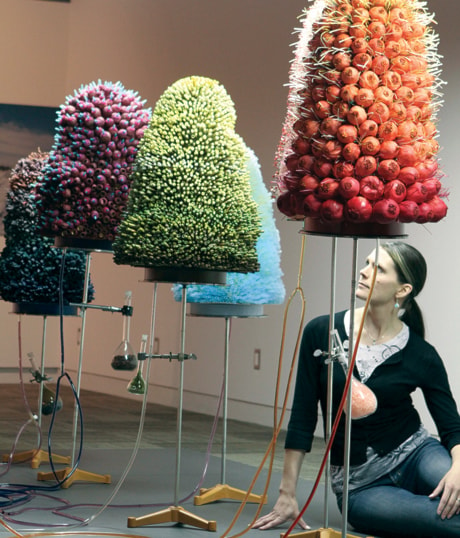You might not look at your breakfast the same way after visiting the Red Deer Museum and Art Gallery’s new exhibition.
The Farm Show, a three-part visual exploration of issues facing today’s farmers is now open and sure to turn a few heads.
“We wanted to look at changes in farming in our area over the past number of years,” said Lorna Johnson, executive director at MAG.
“It seems to be a hot topic lately, especially here, because our community is deeply rooted in farming.”
The Farm Show’s three exhibits — Seeding, Growing, and Harvest — run until November and will be displayed in accordance with the actual parts of the farming season they represent — Seeding runs until June 26, followed by Growing, and Harvest opens in September.
Five Alberta-based artists were selected for the Seeding display, which raises questions about the genetic modification of foods, corporate control of farmlands, and urban sprawl.
“As an art gallery, our job is not to instruct people in how to think or what to think, we just want them to join the discussion,” said Tanya Zuzak, contemporary art curator at MAG.
Zuzak said MAG has been planning the exhibit for nearly two years and is pleased with the diverse range of artistic mediums and ideas represented by the installations.
Upon entering the gallery space, MAG visitors are sure to see Edmonton photographer John Freeman’s new work entitled No More Spring Seeding, a series of panoramic images taken near Edmonton that show urban construction encroaching upon or dominating local farmlands.
Freeman said witnessing the destruction the urban environment was causing to some of the area’s best farmlands over the past four years deserved documentation.
The genetic modification and corporate ownership of seeds is a dominate theme in three of the Farm Show’s exhibits.
Artist Sally Smith crafted large wooden seeds infused with metallic farming equipment parts to create Genetically Modified Seed Pods, a commentary on corporate patenting of modified seeds and the dangers they pose to traditional farming.
Cindy M. Jones’ Steering Committee, a sculpture comprised of objects related to the seeding process echoes the sentiments of Smith; she said the piece is meant to serve as a cautionary statement of the possible consequences from genetic seed modification and controlled reproduction.
Rounding out the Farm Show are two audacious installations that look to the possibly dark future of farming.
Alex Moon’s Uni-Farm is an agricultural science-fiction narrative, in which a battle for agricultural freedom is being waged between the Uni-Farm Corporation and the Real Food Alliance.
Moon’s exhibit features a screening area, running Uni-Farm: Episode 1 — a 17-minute film he made, and a mock laboratory display from the fictional Uni-Farm world.
Lyndal Osborne’s Endless Forms Most Beautiful also focuses on the possible future of seed modification.
Osborne said her display hints at the hidden dangers of engineering seeds to have a terminator gene that does not allow them to be harvested more than once, unless fertilized by a specific chemical.
Johnson said in addition to the Farm Show, MAG will also be running Farming Out Our Future, an art exhibit that analyzes the changes to farming practices over the past 50 years; and From Our Collection, a display of selected objects and artifacts from the museum’s extensive 80,000 piece collection.
The Farm Show’s grand opening is on May 1 from 2 to 4 p.m. and all of its contributing artists will be in attendance.
For more information, visit reddeermuseum.com.
syoung@www.reddeeradvocate.com
